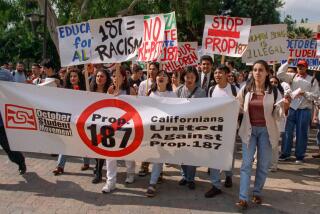Yet Another California Undercount?
Ever since it entered the Union a century and a half ago, California has posed a daunting challenge to those in Washington responsible for reckoning the nation’s population each decade.
Already, the challenge is figuring into this year’s presidential politics. More on that in a moment. First, a little background for Californians who will be answering questionnaires for the 2000 census in coming days.
In 1850, as told in “The American Census” by historian Margo J. Anderson, the newly minted state suffered its first census debacle. Some of the returns were lost in a fire, and President Millard Fillmore’s administration later had to guess the population of San Francisco, Santa Clara and Contra Costa counties.
Then there was the crisis following the 1920 census. Rapidly urbanizing California was forced to forgo three additional House seats for a decade as a Congress split by urban and rural factions failed to reapportion the lower chamber for the first time in the nation’s history.
And after the 1990 census, the state lost out on a House seat and millions of dollars a year in federal funding when top federal officials opted not to adjust the traditional head count with data from a population sample. California’s official population of 29.7 million would have risen by more than 800,000 had the adjustment been made. The state still wound up with an enviable 52 seats in the House--No. 2 New York got 31--but every extra chair helps in a chamber with 435 voting members.
*
One of the lessons from past censuses in California is that the very factors that make the state so dynamic--high rates of immigration and population growth dating to the Gold Rush, and the restless mobility of its inhabitants--also render it hard to canvass. The state simply won’t stand still long enough for the government to get a completely accurate picture of who lives where on April 1, the national census day.
Controversy may well erupt again after the 2000 census and the state, in all likelihood, winds up once more with a sizable undercount that will confront Washington with some hard choices.
This time, the choices won’t deal with the number of seats the state has in Congress. The Supreme Court ruled last year--to cheers from the Republican majority in Congress and boos from Democrats--that only the traditional head count may be used for reapportionment.
But the next president will have to decide whether to release sample-adjusted numbers to states in 2001 for the purpose of redrawing legislative boundaries. That’s a decision with major repercussions for state and national politics. Cities like Los Angeles, with high concentrations of hard-to-count people, could have less or more representation in Sacramento and in Washington depending on how the numbers come out.
The population figures would also determine how much money each state gets from various federal programs in the next decade.
*
Debate is already flaring on the presidential campaign trail.
Vice President Al Gore, the presumed Democratic nominee, says he will support efforts to correct the undercount expected in California and other states with high minority and immigrant populations.
But Texas Gov. George W. Bush, Gore’s expected Republican opponent, has said only that he supports a traditional head count. Asked about this at a March 5 news conference in Oakland, Bush said he stands with his party against sampling. “I think we need to count, actual count,” he said, according to a C-SPAN transcript. “I think we need to spend the money, make the effort and work hard to get an actual count.”
Bush spokesman Scott McClellan later said in a telephone interview that the governor would have to review more information to determine whether he would release sample-adjusted population figures.
Leaders of minority groups in Congress--virtually all Democrats--have been pressing Bush to answer this question for months. The query also has cropped up in Texas, another state likely to wind up with a major undercount.
Democrats are scornful.
“I can’t believe that a governor of a state would ever want to support a process that wouldn’t fully account for every living being in his state. That’s cruelty,” said Rep. Sam Farr (D-Carmel), head of California’s House delegation.
Will census politics affect the November vote in California or elsewhere? Hard to say. Most voters are unlikely to follow the demographic and statistical complexities involved. The Republican argument for a straight head count has the advantage of simplicity and the appeal of what the GOP calls a faithful interpretation of the Constitutional requirement for an “actual enumeration.”
But the Texas Office of State-Federal Relations acknowledged in 1997 in a paper on “priority” policy issues: “All sides in the census debate concede that traditional methods of calculation, which seek to identify and count each individual resident, will never provide a full and accurate portrait of the U.S. population.
“At issue is how to correct what everyone acknowledges is an undercount, and specifically an undercount of certain populations, most often urban minorities.”
More to Read
Get the L.A. Times Politics newsletter
Deeply reported insights into legislation, politics and policy from Sacramento, Washington and beyond. In your inbox three times per week.
You may occasionally receive promotional content from the Los Angeles Times.










